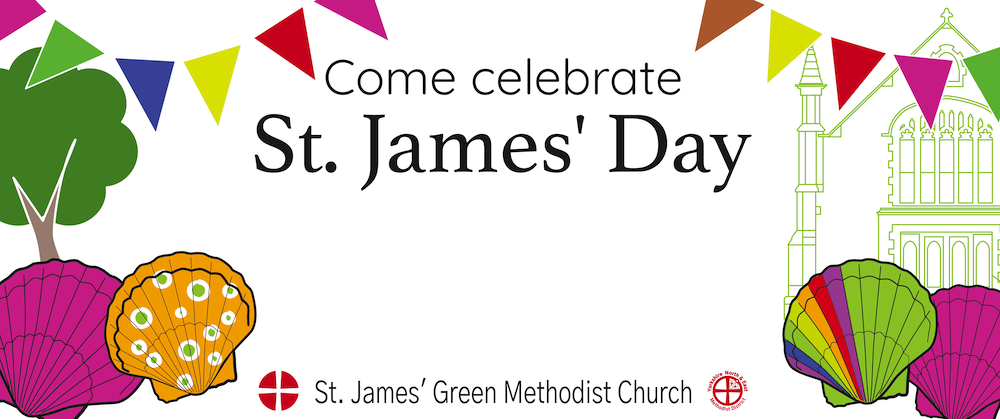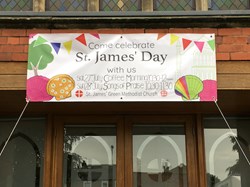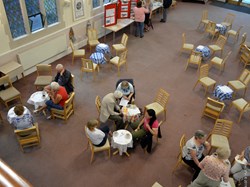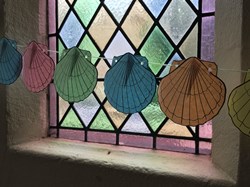St James Day

The Story of the Shell and Saint James.
There are two stories that link Saint James - one of the disciples and apostles of Jesus, and the scallop shell.
Two versions of the most common myth about the origin of the symbol concern the death of Saint James, who was martyred by beheading in Jerusalem in 44 AD. According to Spanish legends, he had spent time preaching the gospel in Spain, but returned to Judaea upon seeing a vision of the Virgin Mary on the bank of the Ebro River.
Version 1: After James's death, his disciples shipped his body to the Iberian Peninsula to be buried in what is now Santiago. Off the coast of Spain, a heavy storm hit the ship, and the body was lost to the ocean. After some time, however, it washed ashore undamaged, covered in scallops.
Version 2: After James's death his body was transported by a ship piloted by an angel, back to the Iberian Peninsula to be buried in what is now Santiago. As the ship approached land, a wedding was taking place on shore. The young groom was on horseback, and on seeing the ship approaching, his horse got spooked, and horse and rider plunged into the sea. Through miraculous intervention, the horse and rider emerged from the water alive, covered in seashells.
The Shell became a symbol for pilgrims who walked The Camino de Santiago "Pilgrimage of Compostela”. known in English as the Way of Saint James. The Camino leads to the shrine of the apostle Saint James the Great in the cathedral of Santiago de Compostela in Galicia in northwestern Spain, where tradition has it that the remains of the saint are buried.
The symbol of the Camino de Santiago, the shell is seen very frequently along the trails.
The shell is seen on posts and signs along the Camino in order to guide pilgrims along the way.
The ‘ribs’ of the shell represent the different paths or ways to finding or discovering Christ in our lives. All paths lead to God.
The shell is even more commonly seen on the pilgrims themselves. Wearing a shell denotes that one is a traveler on the Camino de Santiago. Most pilgrims receive a shell at the beginning of their journey and either attach it to them by sewing it onto their clothes or wearing it around their neck or by simply keeping it in their backpack.
The scallop shell also served practical purposes for pilgrims on the Camino de Santiago. The shell was the right size for gathering water to drink or for eating out of as a makeshift bowl.
During the medieval period, the shell was proof of completion rather than a symbol worn during the pilgrimage.
The shell is still used as a symbol of Christian pilgrimage today and is often seen on old gravestones which show that the deceased was a follower of Christ. At baptism the minister or priest will use a scallop shell to pour water onto a person’s head. Baptism is seen as the start of the christian journey or pilgrimage following Christs way.
How did Saint James Green get its name?
Archeological finds indicate that there was a settlement here in Thirsk around 500–600 BC. The name is derived from the Viking (Old Norse) word þresk meaning fen or lake. By 1145, what is now Old Thirsk was known as a borough and wasn’t under the rule of the Manor. That changed when in 1723 Ralph Bell bought the Manorial rights and it has been held in the same family ever since.
The Domesday book mentions Tresche as having a Manor House and a small settlement of people who farmed the land. That Manor House may have been on the site alongside the Cod Beck where the outline of a raised platform -for a dwelling house and a moat can be seen. There is no mention of any church being nearby. It is thought that the area around what we know as The Green was most likely to be where the humble and basic dwellings were built. Hence the name ‘Old Thirsk” for this area.
In the 12th Century Roger de Mowbray who owned much of North Yorkshire was extremely rich having gained land from the King and his neighbours. He was however generous to the churches that had established in his Manor and gave the Chapel of Saint James to the village of Tresc. It is likely that this village was ‘Old Thirsk’ situated around and on The Green. So the Green got its name from the Chapel that once stood there in 1145. However in a papal census of Thirsk and the area of 1292 it says “In this parish is the borough town of Old Thirsk, where was a chapel of St James, but it is demolished.”
The chapel may have been named after St James because of the links with pilgrimages. Thirsk may have been a stopping and resting point for pilgrims to and from York or Northumberland or for pilgrims visiting the nearby Abbey’s at Rievaulx , Byland or Mount Grace Priory. There are also St James’ churches at Baldersby and Romanby.




